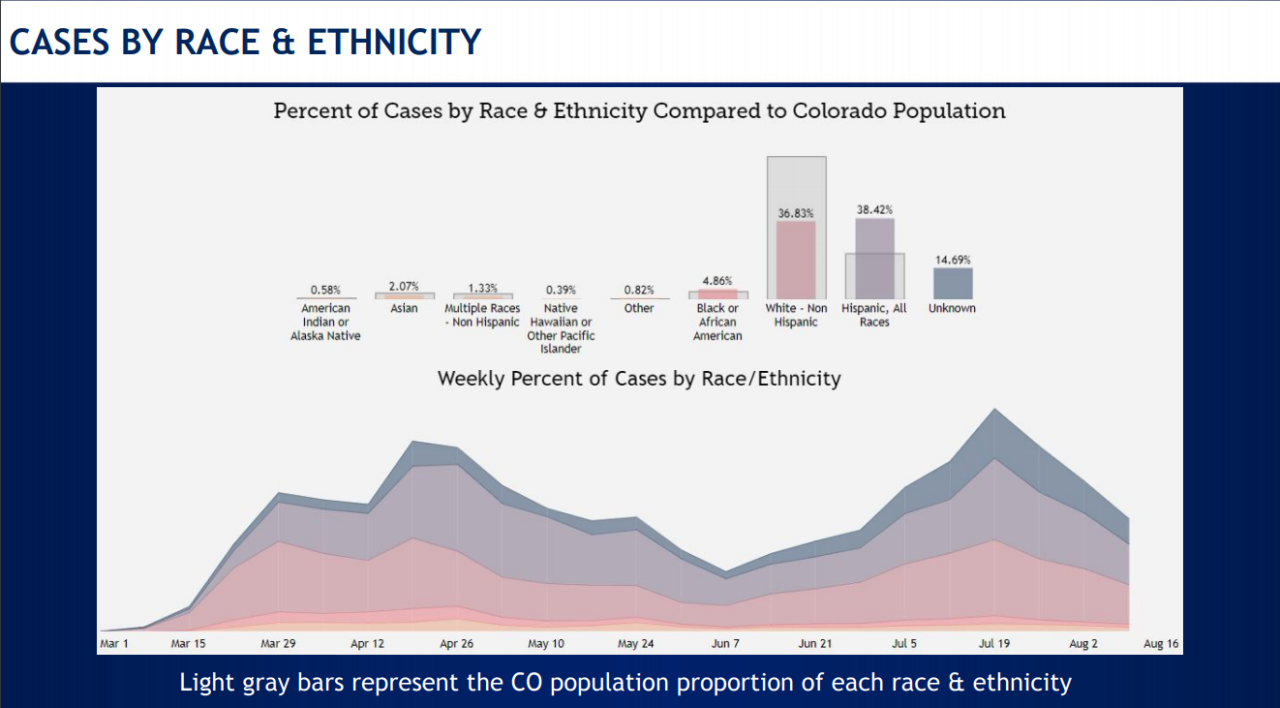DENVER – Colorado started on Friday publishing demographic data of patients who have been hospitalized due to the novel coronavirus in an effort to eradicate longstanding inequalities that disproportionately affect underserved communities, the state’s health department executive director said Thursday.
The demographic hospital data from the Colorado Department of Public Health and Environment (CPDHE) will be published for the first time Friday – three months after the department began collecting the data. About 55% of hospitals across the state had already submitted the data to the CDPHE, collectively accounting for 91% of COVID-19 patients who’ve been treated in Colorado hospitals, a news release from the CDPHE states.
State health officials said the data – from March 1 through Aug. 15 – illustrates not only how serious the effects of the disease can be, but also confirms that COVID-19 is disproportionately affecting Black and Hispanic populations in Colorado.
The data, for example, shows that Blacks and Hispanics have been hospitalized at disproportionately higher rates when compared to their population size statewide:
• Hispanics accounted for nearly 38% of all hospitalized COVID-19 patients, even though they only make up about 22% of Colorado’s total population. The state found that at one point in May, more than 50% of patients across state hospitals were Hispanic.
• Black people, on the other hand, only make up 4.6% of Colorado’s total population, but accounted for nearly 10% of hospitalizations due to COVID-19. State health officials said that trend appears to have improved from March to July, which saw a 10% drop in Black people being hospitalized due to the new respiratory disease. The hospitalization rate for Black people has hovered between 6% and 8% in August, they said.

The numbers from the CDPHE appear to back up what research from the Centers for Disease Control and Prevention (CDC) shows: Among Hispanics and blacks aged 60-79 (an age group at higher risk of severe illness from COVID-19), the prevalence for diabetes or diabetes accompanied by cardiovascular disease was twice as high than among non-Hispanic whites.
Those numbers, coupled with the fact that Hispanics and Blacks are less likely to be insured and much less likely to be able to work from home as they work in jobs which are considered essential, create racial disparities that negatively affect those populations.
The demographic data from the CDPHE released Thursday also demonstrated whites were disproportionately less likely to be hospitalized for COVID-19, as they accounted for 41% of hospitalized patients, even though they represent nearly 68% of the state’s population.
Dr. Rachel Herlihy, the state epidemiologist for the CDPHE, discussed the new dashboards on Friday.
Among some of the other demographic data released by the CDPHE:
• Men were 6% more likely to be hospitalized than woman, with 53% of men hospitalized for COVID-19 versus 47% of women.
• About half of hospitalized patients were 60 or older, and nearly 40% of all hospitalizations were people between 50 and 69 years of age. People younger than 50 years old accounted for 31% of hospitalizations due to COVID-19.
• Children and teens were the least likely to be hospitalized, only accounting for 3% of all statewide hospitalizations.
For those who were hospitalized due to COVID-19 related symptoms, the state found that: 94% tested positive for the coronavirus, 33% spent time in the ICU, 17% of ICU patients died, and 8% of patients who did not need ICU treatment died. About 20% of patients required a ventilator and those who survived spent an average of 9 days in the hospital.
“This hospitalization data is another example of how historical inequities negatively impact health outcomes. That fact is especially apparent during emergencies like the pandemic,” said CDPHE Executive Director Jill Hunsaker-Ryan. “CDPHE, the state of Colorado, and our local partners are dedicated to eradicating these longstanding inequities. It’s why we are investing in community-based testing sites and multilingual communications, as well as fostering robust stakeholder engagement.”
To that end, state health officials said, the agency. Has moved to community testing sites that are open to anyone regardless of immigration status or insurance coverage. The state is also developing an informational campaign that will leverage research that studied historically marginalized populations, according to the news release.
The demographic data will be published in an interactive dashboard on the state’s COVID-19 website on Friday at 4 p.m.



